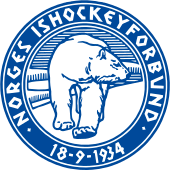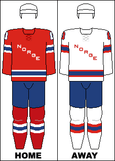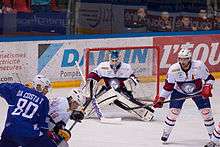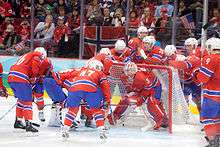Norway men's national ice hockey team
 | |
| Nickname(s) | Isbjørnene (The Polar Bears) |
|---|---|
| Association | NIHF |
| General Manager | Bjørn Mathisrud |
| Head coach | Petter Thoresen |
| Assistants |
Per-Erik Alcén Sjur Robert Nilsen |
| Captain | Jonas Holøs |
| Most games | Tommy Jakobsen (135) |
| Team colors | |
| IIHF code | NOR |
 | |
| Ranking | |
| Current IIHF |
9 |
| Highest IIHF | 8 (2012) |
| Lowest IIHF | 21 (2004) |
| First international | |
|
(London, England; 17 February 1937) | |
| Biggest win | |
|
(Sofia, Bulgaria; 5 March 1975) (Debrecen, Hungary; 22 April 2005) | |
| Biggest defeat | |
|
(Hämeenlinna, Finland; 12 March 1947) | |
| IIHF World Championships | |
| Appearances | 60 (first in 1937) |
| Best result | 4th (1951) |
| Olympics | |
| Appearances | 12 (first in 1952) |
| International record (W–L–T) | |
| 353–634–112 | |
The Norwegian men's national ice hockey team is the national ice hockey team from Norway that participates at the IIHF World Championships. The team is governed by the Norwegian Ice Hockey Association and is coached by Petter Thoresen.
History

The Norwegian Ice Hockey Association was founded in 1934 and, adopting the international rules and regulations of ice hockey, became a member of the International Ice Hockey Federation in 1935.[1][2] Poor finances delayed the formation of a national team until 1937, and continued to hamper its development in the years prior to World War II. After missing out on the 1935 World Championships and 1936 Winter Olympics, the NIHF managed to raise enough funds to send a team to London for the 1937 World Championships. The national ice hockey team thus played its first game on 17 February 1937, losing 0–7 to Czechoslovakia, and was eliminated from the competition following a 2–13 loss to Switzerland.[3] Norway also took part in the next tournament in 1938, but was unable to participate in 1939. Results remained meagre throughout the pre-war years; of the nine international fixtures contested between 1937 and 1940, the closest Norway came to winning was 3–4 in the first game against Sweden, on 20 January 1939.[4]
After the war, the growth of Norwegian ice hockey accelerated as new teams formed and improvements in infrastructure were made. The opening of the state of the art Jordal Amfi in Oslo meant that for a time Norway was at the forefront in terms of facilities.[5] Results began to improve on the international stage, though not before Norway had endured its worst defeat ever at the hands of Finland in 1947.
The period from 1949 to 1953 has been viewed as a "golden age" in the history of the national team, beginning with the maiden victory, a 2–0 win over Belgium at the 1949 World Championships. In 1951, the NIHF appointed Canadian Bud McEachern as head coach. McEachern brought a physical style which suited the players of the generation well,[6] and at the 1951 World Championships, Norway defeated the United States and Great Britain to finish fourth overall. The following year, Norway competed in its first ever Olympic tournament, as host nation of the 1952 Winter Olympics. Finally, in 1953, Norway became the first Western nation to play the Soviet Union, an event that was overshadowed by the death of Joseph Stalin shortly after the team's arrival in Moscow.
The remainder of the decade saw the Norwegians continue to challenge the strongest hockey nations. From the 1960s onwards, however, Norwegian ice hockey fell into decline internationally. The game was becoming increasingly popular at home, but this did not translate into better results against other nations. This has been attributed to poor training conditions. Mild winters meant that a northerly location could no longer make up for the lack of artificial ice rinks, which local politicians were reluctant to support compared to other sports facilities.[7] After the 1965 World Championships, the Norwegian team was no longer allowed to compete at the highest level, and the NIHF resigned itself to competing at the top of Pool B instead.[7] Qualifying for the Winter Olympics was still within reach, however, and Norway managed to do so in both 1964 and 1968.
Norway slipped further into mediocrity during the 1970s, suffering relegation to Pool C after finishing in last place in Pool B of the 1972 World Championships. Once again, the NIHF was forced to revise its objectives; not to return to Pool A, but merely to survive in Pool B. The goal of qualifying for the Winter Olympics remained throughout this period, but after another stint in Pool C in 1975, the ice hockey tournament at the 1976 Winter Olympics went ahead without Norwegian participation.[7]
In addition to the continuing lack of political will to improve training conditions, the bleak situation during the 1970s had been compounded by a growing reluctance among players to represent Norway internationally.[7] This trend was finally reversed under the leadership of Georg Smefjell and Olav Dalsøren from 1978 to 1980. Smefjell and Dalsøren also succeeded in leading Norway back to the Winter Olympics. At the 1979 World Championships, Norway finished fourth in Pool B and qualified for the 1980 Winter Olympics in Lake Placid. There, the team showed encouraging signs for the future, despite losing heavily against the top tier nations and eventually coming away from the tournament with only a single point.[8]

The appointment of Ronald Pettersson as head coach in 1980 heralded an era of Swedish influence on Norwegian international ice hockey. For the next nine years, four Swedish coaches in a row took charge of a team that proved to be highly unstable. For Pettersson, the 1981 World Championships were a disappointment. Wins against Yugoslavia and Japan were barely enough to avoid relegation from Pool B. His successor, Arne Strömberg experienced similar difficulties. At the 1982 World Championships, an otherwise strong performance was blighted by losses against newly promoted China and Austria.[8]
The next Swedish import was Hans Westberg in 1982, whose unorthodox methods lead Norway to the 1984 Winter Olympics. Expectations ahead of the Olympic tournament were only partially met, the 3–3 draw against the United States being the most notable result.[8][9] The following season, while initially promising, ended in catastrophe at the 1985 World Championships as Norway dropped out of Pool B for the third time.[10]
Norway stabilized itself in the lower half of Pool A in the 1990s, but the team was relegated again in 1997. After a spell with Swedish coach Leif Boork, Roy Johansen was hired in 2001. A new era of slow, but steady, growth began and Norway climbed thirteen places in the IIHF World Ranking during Johansen's reign, from a 21st place in 2004, to an 8th place in 2012. Johansen stepped down as head coach in 2016 and was replaced by Petter Thoresen.
Tournament record
Olympic record

| Games | GP | W | OW | T | OL | L | GF | GA | Coach | Captain | Finish | Rank |
|---|---|---|---|---|---|---|---|---|---|---|---|---|
| 8 | 0 | 0 | 0 | 0 | 8 | 15 | 46 | Bud McEachern | Round-robin | 9th | ||
| Did not participate | ||||||||||||
| Did not participate | ||||||||||||
| 7 | 5 | 0 | 0 | 0 | 2 | 40 | 19 | Rolf Kirkvaag | Consolation Round (Group B) | 10th | ||
| 6 | 3 | 0 | 0 | 0 | 3 | 16 | 18 | Egil Bjerklund | Consolation Round (Group B) | 11th | ||
| 5 | 3 | 0 | 0 | 0 | 2 | 17 | 27 | Ake Brask | Consolation Round | 8th | ||
| Did not participate | ||||||||||||
| 5 | 0 | 0 | 1 | 0 | 4 | 9 | 36 | Ronald Pettersson, Olav Dalsøren | First round | 11th | ||
| 7 | 1 | 0 | 1 | 0 | 5 | 15 | 43 | Hans Westberg | First round | 12th | ||
| 6 | 0 | 0 | 1 | 0 | 5 | 18 | 38 | Lenhart Åhlberg, Tore Jobs | 11th place game | 12th | ||
| 6 | 1 | 0 | 0 | 0 | 5 | 12 | 40 | Bengt Olsson, Tore Jobs | 9th Place Match | 9th | ||
| 7 | 1 | 0 | 0 | 0 | 6 | 11 | 26 | Bengt Olsson, Tore Jobs | 11th Place Match | 11th | ||
| Did not qualify | ||||||||||||
| Did not qualify | ||||||||||||
| Did not qualify | ||||||||||||
| 4 | 0 | 0 | – | 1 | 3 | 8 | 23 | Roy Johansen | Tommy Jakobsen | Qualification playoffs | 10th | |
| 4 | 0 | 0 | – | 0 | 4 | 3 | 16 | Ole-Kristian Tollefsen | Qualification playoffs | 12th | ||
| 5 | 0 | 1 | – | 1 | 3 | 5 | 18 | Petter Thoresen | Jonas Holøs | Quarterfinals | 8th | |
World Championship
|
|
Team
Current roster
Roster for the 2018 IIHF World Championship.[11]
Head coach: Petter Thoresen
| No. | Pos. | Name | Height | Weight | Birthdate | Team |
|---|---|---|---|---|---|---|
| 4 | D | Johannes Johannesen | 1.81 m (5 ft 11 in) | 85 kg (187 lb) | March 1, 1997 | |
| 6 | D | Jonas Holøs – C | 1.80 m (5 ft 11 in) | 93 kg (205 lb) | August 27, 1987 | |
| 8 | F | Mathias Trettenes | 1.79 m (5 ft 10 in) | 76 kg (168 lb) | November 8, 1993 | |
| 12 | F | Michael Haga | 1.80 m (5 ft 11 in) | 77 kg (170 lb) | March 10, 1992 | |
| 14 | D | Dennis Sveum | 1.85 m (6 ft 1 in) | 86 kg (190 lb) | November 27, 1986 | |
| 15 | F | Tommy Kristiansen | 1.89 m (6 ft 2 in) | 98 kg (216 lb) | May 26, 1989 | |
| 16 | F | Eirik Salsten | 1.84 m (6 ft 0 in) | 90 kg (200 lb) | June 17, 1994 | |
| 17 | D | Stefan Espeland | 1.84 m (6 ft 0 in) | 84 kg (185 lb) | March 24, 1989 | |
| 18 | F | Tobias Lindström | 1.77 m (5 ft 10 in) | 92 kg (203 lb) | April 20, 1988 | |
| 20 | F | Anders Bastiansen – A | 1.90 m (6 ft 3 in) | 93 kg (205 lb) | October 31, 1980 | |
| 21 | F | Steffen Thoresen | 1.80 m (5 ft 11 in) | 88 kg (194 lb) | June 3, 1985 | |
| 22 | F | Martin Røymark | 1.84 m (6 ft 0 in) | 86 kg (190 lb) | November 10, 1986 | |
| 26 | F | Kristian Forsberg | 1.85 m (6 ft 1 in) | 88 kg (194 lb) | May 5, 1986 | |
| 27 | F | Ludvig Hoff | 1.83 m (6 ft 0 in) | 86 kg (190 lb) | October 16, 1996 | |
| 28 | F | Niklas Roest | 1.74 m (5 ft 9 in) | 80 kg (180 lb) | August 3, 1986 | |
| 30 | G | Lars Haugen | 1.85 m (6 ft 1 in) | 83 kg (183 lb) | March 19, 1987 | |
| 33 | G | Henrik Haukeland | 1.86 m (6 ft 1 in) | 83 kg (183 lb) | December 6, 1994 | |
| 37 | D | Villiam Strøm | 1.91 m (6 ft 3 in) | 95 kg (209 lb) | December 10, 1990 | |
| 38 | G | Henrik Holm | 1.85 m (6 ft 1 in) | 80 kg (180 lb) | September 6, 1990 | |
| 40 | F | Ken André Olimb | 1.79 m (5 ft 10 in) | 81 kg (179 lb) | January 21, 1989 | |
| 43 | D | Christian Bull | 1.86 m (6 ft 1 in) | 90 kg (200 lb) | August 13, 1996 | |
| 46 | F | Mathis Olimb – A | 1.77 m (5 ft 10 in) | 79 kg (174 lb) | February 1, 1986 | |
| 47 | D | Alexander Bonsaksen | 1.80 m (5 ft 11 in) | 84 kg (185 lb) | January 24, 1987 | |
| 90 | D | Daniel Sørvik | 1.83 m (6 ft 0 in) | 83 kg (183 lb) | March 11, 1990 | |
| 93 | F | Thomas Valkvæ Olsen | 1.86 m (6 ft 1 in) | 88 kg (194 lb) | May 18, 1993 |
Individual all-time records
Most matches played
| Player | Time | Matches | Club on debut |
|---|---|---|---|
| Tommy Jakobsen (D) | 1992–2010 | 139 | Furuset |
| Mats Trygg (D) | 1999–present | 122 | Manglerud Star |
| Jim Marthinsen (G) | 1980–1995 | 114 | Vålerenga |
| Thor Martinsen (D) | 1964–1980 | 113 | Frisk Tigers |
| Per-Åge Skrøder (F) | 1999–present | 113 | Lillehammer |
| Mads Hansen (F) | 2000-present | 110 | Storhamar |
| Erik Kristiansen (F) | 1983–1994 | 97 | Storhamar |
| Ole Eskild Dahlstrøm (F) | 1989–2005 | 96 | Furuset |
| Petter Thoresen (F) | 1980–1995 | 96 | Vålerenga |
| Petter Salsten (D) | 1987–1995 | 92 | Furuset |
| Tore Vikingstad (F) | 1995–2010 | 88 | Stjernen |
| Trond Magnussen (F) | 1992–2004 | 88 | Stjernen |
| Ørjan Løvdal (F) | 1983–1995 | 83 | Stjernen |
| Marius Trygg (F) | 1999–present | 82 | Manglerud Star |
| Robert Schistad (G) | 1991–2000 | 82 | Viking |
| Morten Ask (F) | 2000-present | 82 | Vålerenga |
Last updated: 4 January 2015
Source: hockey.no
Other notable players
- Geir Hoff
- Ron 'Ole' Bakerson
- Martin Knold
- Åge Ellingsen
- Jenson Stott
- Roy Johansen
- Bjørn "Botta" Skaare
- Espen "Shampo" Knutsen
- Morten Ask
- Anders Myrvold
- Patrick Thoresen
- Ole-Kristian Tollefsen
- Mats Zuccarello Aasen
Note: Still active players are bolded
References
- ↑ Langholm, Dag (1984). Norsk ishockey gjennom 50 år. pp. 39–40.
- ↑ "Norway". International Ice Hockey Federation. Retrieved 22 June 2011.
- ↑ Langholm, Dag (1984). Norsk ishockey gjennom 50 år. pp. 59–62.
- ↑ Langholm, Dag (1984). Norsk ishockey gjennom 50 år. pp. 71–72.
- ↑ Langholm, Dag (1984). Norsk ishockey gjennom 50 år. pp. 97–101.
- ↑ Langholm, Dag (1984). Norsk ishockey gjennom 50 år. p. 97.
- 1 2 3 4 Langholm, Dag (1984). Norsk ishockey gjennom 50 år. pp. 105–112.
- 1 2 3 Langholm, Dag (1984). Norsk ishockey gjennom 50 år. pp. 115–126.
- ↑ "Berettning A-Landslaget 1983–1984". Norwegian Ice Hockey Association (in Norwegian). 30 August 2005. Retrieved 9 January 2012.
- ↑ "Seniorlandslagene 1984/1985". Norwegian Ice Hockey Association (in Norwegian). 26 June 2005. Retrieved 9 January 2012.
- ↑ 2018 IIHF World Championship roster
- Langholm, Dag (1984). Norsk ishockey gjennom 50 år. Norwegian Ice Hockey Association.